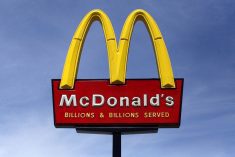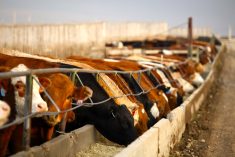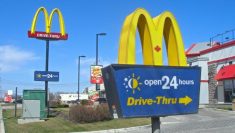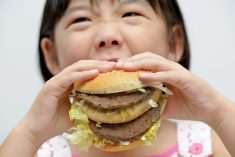Reuters — McDonald’s Corp.’s new CEO said on Monday he would reorganize business units, sell restaurants to franchisees and cut costs in a bid to turn the fast-food chain into a “modern, progressive burger company.”
The anticipated video announcement by CEO Steve Easterbrook left investors hungry for specific details on how the world’s biggest restaurant chain would try to improve consumer perceptions of food quality and slow service.
“I will not shy away from the urgent need to reset this business,” said Easterbrook, who took the helm on March 1, following one of McDonald’s most dismal years on record.
Read Also

U.S. livestock: Feeder cattle hit contract highs on tight supply
Chicago | Reuters – All Chicago Mercantile Exchange feeder cattle futures and most live cattle futures hit contract highs on…
Shares were down nearly two per cent in premarket trading, then retraced losses to stand off 0.1 per cent at $97.70 on the New York Stock Exchange as investors digested the news (all figures US$).
“Judging by the immediate investor reaction, there appears to be more of a ‘prove it’ sentiment among investors, rather than an full embrace of Mr. Easterbrook’s plan,” Miller Tabak + Co. analyst Stephen Anderson said in a client note.
Easterbrook said McDonald’s will sell 3,500 restaurants to franchisees by 2018, taking global franchisee ownership to 90 per cent from 81 per cent. McDonald’s prior plan called for selling 1,500 restaurants by 2016.
In Canada, the company today reports about 80 per cent of its 1,400-odd restaurants are “locally owned and operated” by independent franchisees.
Easterbrook vowed to remove “cumbersome” management and scour the business for inefficiencies to find about $300 million in net annual savings, most of which will be realized by the end of 2017.
Easterbrook also said McDonald’s would return $8 billion to $9 billion to shareholders in 2015.
Canada in “international lead” market
McDonald’s currently organizes its business around major geographic markets: the U.S., Europe, and Asia/Pacific, the Middle East and Africa (APMEA).
Easterbrook said the new segments, which become effective July 1, will be organized around business similarities.
The U.S. market, which accounts for more than 40 per cent of McDonald’s operating income, will continue to be led by Mike Andres.
The new “international lead” market will include Canada, Australia, France, Germany, and the United Kingdom, which make up a total of 40 per cent of McDonald’s operating income. It will be led by Doug Goare, current president of McDonald’s Europe.
Dave Hoffman, now president of McDonald’s APMEA unit, will lead a new “high-growth” market that includes China, Italy, Poland, Russia, South Korea, Spain, Switzerland and the Netherlands. Those countries account for about 10 per cent of operating income.
The “foundational” market includes the remaining countries where McDonald’s operates. It will be run by Ian Borden, currently APMEA’s chief financial officer.
— Lisa Baertlein is a Reuters correspondent covering the restaurant and grocery sectors from Los Angeles.
















